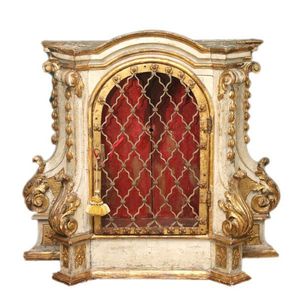Neoclassical Pot Pourri with Swan Legs and Flowers
You must be a subscriber, and be logged in to view price and dealer details.
Subscribe Now to view actual auction price for this item
When you subscribe, you have the option of setting the currency in which to display prices to $Au, $US, $NZ or Stg.
- Circa - A Latin term meaning 'about', often used in the antique trade to give an approximate date for the piece, usually considered to be five years on either side of the circa year. Thus, circa 1900 means the piece was made about 1900, probably between 1895 and 1905. The expression is sometimes abbreviated to c.1900.
- Finial - An architectural decoration, found on the upper parts of of an object. On furniture they are usually found on pediments, canopies and shelf supports. On smaller ceramic or silver items, such as spoons, they may decorate the top of the item itself, or the lid or cover where they provide a useful handle for removal.
Finials have a variety of shapes and forms. They may be urn-shaped, baluster shaped round or spiral, but usually taper into an upper point. Many real life shapes may also be used as finials, such as pineapples, berries, pinecones, buds, lotus and acorns. Sometimes animals such as a lion are depicted, or fish and dolphins. - Firing Crack - A firing crack is a crack in a porcelain or stoneware item that occurs whilst the item is in the kiln.They are usually caused by faulty design, where one part is thicker than the surrounding area, and being thicker it cools more slowly, setting up a stress with the surrounding area. Firing cracks are not often seen on modern mass produced porcelain, as the damaged items are discarded during prooduction. However they are seen in earlier items and artisan-produced objects.
- Acanthus - A stylized leaf motif, one of the primary decorative elements of classical Greek and Roman architecture, derived from the genus of flowering plants in the family Acanthaceae, native to tropical and subtropical regions of the Mediterranean area. It is a common element in classical Greek and Roman design, and is often seen in Corinthian and Composite order columns and used as a decorative element in English, European and Australian furniture, particularly on the curve of a leg, and as decoration for a corbel.
- Lappet Decoration - In the context of furniture, ceramics, and oriental wares, the word "lappet" refers to a decorative motif that consists of a repeated pattern of stylized or abstracted "lappets."
A lappet in this context is a decorative element that resembles a small, hanging flap of cloth or fabric, but rather are stylized patterns that resemble the shapes and folds of lappets. They can be found on a wide range of objects, including furniture, vases, bowls, and plates.
Lappet decoration can take many different forms, but typically consists of a series of semi-circular or pointed shapes that are repeated in a continuous pattern. The shapes may be simple or highly ornate and may be arranged in a regular or irregular pattern. The design may also include other decorative elements, such as floral or foliate motifs.
Lappet decoration is often associated with Asian design traditions, and can be found on a wide range of objects from these regions, including Chinese porcelain, where lappet decoration is often used as a symbol of abundance and prosperity, and is believed to have protective and auspicious qualities.
This item has been included into following indexes:
-
Royal Worcester (England), item types
- other 3,388
- pot pourri 290
- urns 424
Visually similar items

A 19th century French ormolu and cloisonne highly decorative mantel clock, the front with two hand painted classical porcelain panels of a gent and his companion, cloisonne inlay to the frame, finials and large urn form pediment, the conforming circular fr

A circa 1700 Italian painted and gilded carved wood tabernacle with gilded metal door, 73 cm high

Early gilt wood framed mirror. Scrollwork mounts. Height 153 cm, Wt. 84 cm

A Georgian gold and gemset brooch, in the shape of a small square picture frame. The central crystal frame containing gold entwined monogram on a pink ground. The surrounding border set with four small rubies, three square emeralds and one square peridot.
